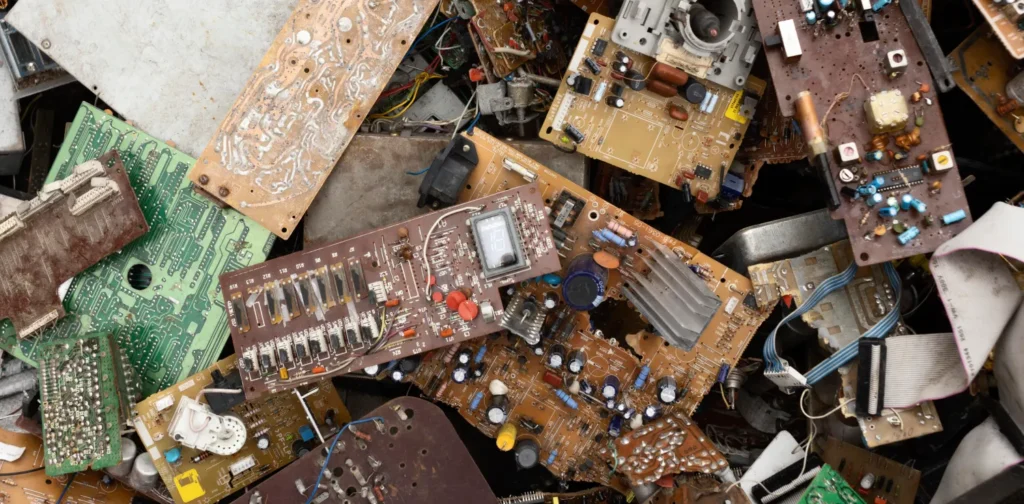Reducing E-Waste by Making Recyclable and Healable Electronics

Photo: Freepik
From work to entertainment, electronic devices connect and assist us daily. However, as consumption patterns change and things get replaced more frequently, including electronics, the waste we leave behind becomes a mounting problem. In this light, researchers have developed a type of circuit board that is more durable and easier to recycle in the effort of reducing e-waste.
Urgency of Reducing E-Waste
From phones and tablets to everyday appliances, electronics have become an inseparable part of modern life. But their growing presence comes at a high cost: electronic waste.
Devices like phones, laptops, or electronic toys are thrown away when they are broken or no longer in use. The Global e-Waste Monitor 2024 by the United Nations reports that the amount of electronic waste has almost doubled in the past 12 years, reaching 62 million tonnes. By 2030, e-waste is expected to grow to 82 million tonnes. So, reducing e-waste is crucial in easing the burden of the global waste management system.
What is more worrying is that only about 20% of this waste gets properly recycled. The rest of it ends up in landfills or gets burned, releasing toxic chemicals into the environment. Moreover, inside these discarded devices are valuable materials like gold and gallium, also often lost forever during disposal.
Materials: Issue and Potential Solution
The problem about e-waste lies not just in the volume, but also in the materials. Most circuit boards are made from thermoset plastics, which are incredibly durable but cannot be reshaped or recycled easily. Once damaged, they are nearly impossible to recover, making electronics a major contributor to global waste.
In this light, the findings by researchers at Virginia Tech may offer a solution. They developed a recyclable and healable circuit board made from two key materials: a special plastic called a vitrimer and tiny droplets of liquid metal source.
If the circuit is damaged, a little heat will melt and reshape it, allowing it to heal itself and keep working. The liquid metal inside carries electricity like copper wires; but unlike metal parts that break or crack, these liquid paths flow around the damage. Even after being bent, cut, or stretched, the circuit continues working in lighting up LEDs and carrying current just like before. It all results in a circuit board that is strong, flexible, and repairable.
To recycle it, the researchers used a simple alkaline solution to break down the plastic while recovering the metal and components. This means old circuits could be disassembled, cleaned, and reused. This innovation offers a potential solution for the efforts of reducing e-waste.
Toward Circularity for Electronics
Innovations often mark the shift from the old way to the new one, but for its benefits to be fully realized, we need more than scientific breakthroughs. Real change will require cooperation between industry, policymakers, and consumers.
In terms of reducing e-waste, governments can play a key role by incentivizing sustainable design and updating e-waste regulations to include recyclable circuit materials. Industries must be willing to invest in sustainable alternatives, embracing materials that are easy to disassemble and products that are made for repair. Meanwhile, researchers will need continued support to scale these innovations from the lab to the market.
Consumers also have a role to play by demanding longer-lasting products and supporting brands that commit to a circular economy. Coming together to repair broken electronics in lieu of continuously buying new things can also be an impactful way to reduce e-waste.
All in all, the problem of e-waste will not disappear overnight; but with collective effort, a healthier and more sustainable future can be within reach, one step at a time.
Editor: Nazalea Kusuma & Kresentia Madina
Dinda Rahmania
Dinda adalah Reporter di Green Network Asia. Ia belajar Ilmu Hubungan Internasional di President University. Dinda bersemangat menulis seputar isu keberagaman, konsumsi berkelanjutan, dan pemberdayaan.


 Weaving the Thread Between the Last Elephant and the Floods in Sumatra
Weaving the Thread Between the Last Elephant and the Floods in Sumatra  Bringing Buried Rivers Back to Life Through Daylighting
Bringing Buried Rivers Back to Life Through Daylighting  Prescribing Beyond Profit for CEOs’ Anxiety
Prescribing Beyond Profit for CEOs’ Anxiety  An Interview with May Tan-Mullins, CEO and Provost of University of Reading Malaysia
An Interview with May Tan-Mullins, CEO and Provost of University of Reading Malaysia  An Interview with Eu Chin Fen, CEO of Frasers Hospitality
An Interview with Eu Chin Fen, CEO of Frasers Hospitality  The UK Government’s Funding Package Plan to Tackle Youth Unemployment
The UK Government’s Funding Package Plan to Tackle Youth Unemployment